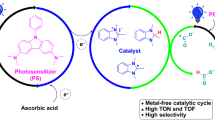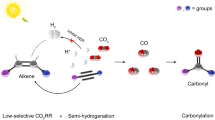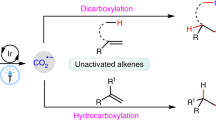Abstract
It is highly desirable to discover molecular catalysts with controlled selectivity for visible-light-driven CO2 reduction to fuels. In the design of catalysts employing earth-abundant metals, progress has been made for CO production, but formate generation has been observed more rarely. Here, we report a binuclear Co complex bearing a bi-quaterpyridine ligand that can selectively reduce CO2 to HCOO− or CO under visible light irradiation. Selective formate production (maximum of 97%) was obtained with a turnover number of up to 821 in basic acetonitrile solution. Conversely, in the presence of a weak acid, CO2 reduction affords CO with high selectivity (maximum of 99%) and a maximum turnover number of 829. The catalytic process is controlled by the two Co atoms acting synergistically, and the selectivity can be steered towards the desired product by simply changing the acid co-substrate.
This is a preview of subscription content, access via your institution
Access options
Access Nature and 54 other Nature Portfolio journals
Get Nature+, our best-value online-access subscription
$29.99 / 30 days
cancel any time
Subscribe to this journal
Receive 12 digital issues and online access to articles
$119.00 per year
only $9.92 per issue
Buy this article
- Purchase on Springer Link
- Instant access to full article PDF
Prices may be subject to local taxes which are calculated during checkout





Similar content being viewed by others
Data availability
Crystallographic data for [Co2(biqpy)Cl(MeOH)(H2O)](ClO4)3 have been deposited at the Cambridge Crystallographic Data Centre (CCDC no. 1858669. The data that support the plots within this paper and other findings of this study are available from the corresponding author upon reasonable request.
Change history
28 August 2019
An amendment to this paper has been published and can be accessed via a link at the top of the paper.
References
Aresta, M., Dibenedetto, A. & Angelini, A. Catalysis for the valorization of exhaust carbon: from CO2 to chemicals, materials and fuels. Technological use of CO2. Chem. Rev. 114, 1709–1742 (2014).
Jhong, H.-R. M., Ma, S. & Kenis, P. J. A. Electrochemical conversion of CO2 to useful chemicals: current status, remaining challenges and future opportunities. Curr. Opin. Chem. Eng. 2, 191–199 (2013).
Seh, Z. W. et al. Combining theory and experiment in electrocatalysis: insights into materials design. Science 355, eaad4998 (2017).
Fujita, E. Photochemical carbon dioxide reduction with metal complexes. Coord. Chem. Rev. 185–186, 373–384 (1999).
Tamaki, Y., Morimoto, T., Koike, K. & Ishitani, O. Photocatalytic CO2 reduction with high turnover frequency and selectivity of formic acid formation using Ru(ii) multinuclear complexes. Proc. Natl Acad. Sci. USA 109, 15673–15678 (2012).
Rosas-Hernández, A., Junge, H. & Beller, M. Photochemical reduction of carbon dioxide to formic acid using ruthenium(ii)-based catalysts and visible light. ChemCatChem 7, 3316–3321 (2015).
Tamaki, Y., Koike, K. & Ishitani, O. Highly efficient, selective, and durable photocatalytic system for CO2 reduction to formic acid. Chem. Sci. 6, 7213–7221 (2015).
Sato, S., Morikawa, T., Kajino, T. & Ishitani, O. A highly efficient mononuclear iridium complex photocatalyst for CO2 reduction under visible light. Angew. Chem. Int. Ed. 52, 988–992 (2013).
Reithmeier, R. O. et al. Mono- and bimetallic Ir(iii) based catalysts for the homogeneous photocatalytic reduction of CO2 under visible light irradiation. New insights into catalyst deactivation. Dalton Trans. 43, 13259–13269 (2014).
Reithmeier, R. O., Meister, S., Siebel, A. & Rieger, B. Synthesis and characterization of a trinuclear iridium(iii) based catalyst for the photocatalytic reduction of CO2. Dalton Trans. 44, 6466–6472 (2015).
Hawecker, J., Lehn, J.-M. & Ziessel, R. Efficient photochemical reduction of CO2 to CO by visible light irradiation of systems containing Re(bipy)(CO)3X or Ru(bipy)3 2+–Co2+ combinations as homogeneous catalysts. J. Chem. Soc. Chem. Commun. 536–538 (1983).
Takeda, H., Koike, K., Inoue, H. & Ishitani, O. Development of an efficient photocatalytic system for CO2 reduction using rhenium(i) complexes based on mechanistic studies. J. Am. Chem. Soc. 130, 2023–2031 (2008).
Takeda, H. & Ishitani, O. Development of efficient photocatalytic systems for CO2 reduction using mononuclear and multinuclear metal complexes based on mechanistic studies. Coord. Chem. Rev. 254, 346–354 (2010).
Agarwal, J., Fujita, E., Schaefer, H. F. & Muckerman, J. T. Mechanisms for CO production from CO2 using reduced rhenium tricarbonyl catalysts. J. Am. Chem. Soc. 134, 5180–5186 (2012).
Yamazaki, Y., Takeda, H. & Ishitani, O. Photocatalytic reduction of CO2 using metal complexes. J. Photochem. Photobiol. C 25, 106–137 (2015).
Lehn, J.-M. & Ziessel, R. Photochemical generation of carbon monoxide and hydrogen by reduction of carbon dioxide and water under visible light irradiation. Proc. Natl Acad. Sci. USA 79, 701–704 (1982).
Varma, S. et al. Efficient photocatalytic hydrogen production in water using a cobalt(iii) tetraaza-macrocyclic catalyst: electrochemical generation of the low-valent Co(i) species and its reactivity toward proton reduction. Phys. Chem. Chem. Phys. 15, 17544–17552 (2013).
Chan, S. L.-F., Lam, T. L., Yang, C., Yan, S.-C. & Cheng, N. M. A robust and efficient cobalt molecular catalyst for CO2 reduction. Chem. Commun. 51, 7799–7801 (2015).
Chen, L. et al. Molecular catalysis of the electrochemical and photochemical reduction of CO2 with earth-abundant metal complexes. selective production of CO vs HCOOH by switching of the metal center. J. Am. Chem. Soc. 137, 10918–10921 (2015).
Tinnemans, A. H. A., Koster, T. P. M., Thewissen, D. H. M. W. & Mackor, A. Tetraaza-macrocyclic cobalt(ii) and nickel(ii) complexes as electron-transfer agents in the photo(electro)chemical and electrochemical reduction of carbon dioxide. Recl. Trav. Chim. Pays-Bas 103, 288–295 (1984).
Thoi, V. S., Kornienko, N., Margarit, C. G., Yang, P. & Chang, C. J. Visible-light photoredox catalysis: selective reduction of carbon dioxide to carbon monoxide by a nickel N-heterocyclic carbene–isoquinoline complex. J. Am. Chem. Soc. 135, 14413–14424 (2013).
Bonin, J., Robert, M. & Routier, M. Selective and efficient photocatalytic CO2 reduction to CO using visible light and an iron-based homogeneous catalyst. J. Am. Chem. Soc. 136, 16768–16771 (2014).
Takeda, H., Ohashi, K., Sekine, A. & Ishitani, O. Photocatalytic CO2 reduction using Cu(i) photosensitizers with a Fe(ii) catalyst. J. Am. Chem. Soc. 138, 4354–4357 (2016).
Alsabeh, P. G. et al. Iron-catalyzed photoreduction of carbon dioxide to synthesis gas. Catal. Sci. Technol. 6, 3623–3630 (2016).
Rao, H., Schmidt, L. C., Bonin, J. & Robert, M. Visible-light-driven methane formation from CO2 with a molecular iron catalyst. Nature 548, 74 (2017).
Takeda, H., Koizumi, H., Okamoto, K. & Ishitani, O. Photocatalytic CO2 reduction using a Mn complex as a catalyst. Chem. Commun. 50, 1491–1493 (2014).
Torralba-Peñalver, E., Luo, Y., Compain, J.-D., Chardon-Noblat, S. & Fabre, B. Selective catalytic electroreduction of CO2 at silicon nanowires (SiNWs) photocathodes using non-noble metal-based manganese carbonyl bipyridyl molecular catalysts in solution and grafted onto SiNWs. ACS Catal. 5, 6138–6147 (2015).
Fei, H., Sampson, M. D., Lee, Y., Kubiak, C. P. & Cohen, S. M. Photocatalytic CO2 reduction to formate using a Mn(i) molecular catalyst in a robust metal–organic framework. Inorg. Chem. 54, 6821–6828 (2015).
Cheung, P. L., Machan, C. W., Malkhasian, A. Y. S., Agarwal, J. & Kubiak, C. P. Photocatalytic reduction of carbon dioxide to CO and HCO2H using fac-Mn(CN)(bpy)(CO)3. Inorg. Chem. 55, 3192–3198 (2016).
Guo, Z. et al. Photocatalytic conversion of CO2 to CO by a copper(ii) quaterpyridine complex. ChemSusChem 10, 4009–4013 (2017).
Liu, W. J. et al. A copper(ii) molecular catalyst for efficient and selective photochemical reduction of CO2 to CO in a water-containing system. Chem. Eur. J. 24, 4503–4508 (2018).
Boston, D. J., Xu, C., Armstrong, D. W. & MacDonnell, F. M. Photochemical reduction of carbon dioxide to methanol and formate in a homogeneous system with pyridinium catalysts. J. Am. Chem. Soc. 135, 16252–16255 (2013).
Takeda, H., Cometto, C., Ishitani, O. & Robert, M. Electrons, photons, protons and earth-abundant metal complexes for molecular catalysis of CO2 reduction. ACS Catal. 7, 70–88 (2017).
Rao, H., Bonin, J. & Robert, M. Toward visible-light photochemical CO2-to-CH4 conversion in aqueous solutions using sensitized molecular catalysis. J. Phys. Chem. C. 122, 13834–13839 (2018).
Mellmann, D., Sponholz, P., Junge, H. & Beller, M. Formic acid as a hydrogen storage material—development of homogeneous catalysts for selective hydrogen release. Chem. Soc. Rev. 45, 3954–3988 (2016).
Yu, X. & Pickup, P. G. Recent advances in direct formic acid fuel cells (DFAFC). J. Power Sources 182, 124–132 (2008).
Li, H. et al. Integrated electromicrobial conversion of CO2 to higher alcohols. Science 335, 1596–1596 (2012).
Loges, B., Boddien, A., Gärtner, F., Junge, H. & Beller, M. Catalytic generation of hydrogen from formic acid and its derivatives: useful hydrogen storage materials. Top. Catal. 53, 902–914 (2010).
Guo, Z. et al. Highly efficient and selective photocatalytic CO2 reduction by iron and cobalt quaterpyridine complexes. J. Am. Chem. Soc. 138, 9413–9416 (2016).
Matsuoka, S. et al. Efficient and selective electron mediation of cobalt complexes with cyclam and related macrocycles in the p-terphenyl-catalyzed photoreduction of carbon dioxide. J. Am. Chem. Soc. 115, 601–609 (1993).
Jeoung, J.-H. & Dobbek, H. Carbon dioxide activation at the Ni,Fe-cluster of anaerobic carbon monoxide dehydrogenase. Science 318, 1461–1464 (2007).
Appel, A. M. et al. Frontiers, opportunities and challenges in biochemical and chemical catalysis of CO2 fixation. Chem. Rev. 113, 6621–6658 (2013).
Wang, J.-W., Zhong, D.-C. & Lu, T.-B. Artificial photosynthesis: catalytic water oxidation and CO2 reduction by dinuclear non-noble-metal molecular catalysts. Coord. Chem. Rev. 377, 225–236 (2018).
Ouyang, T., Huang, H.-H., Wang, J.-W., Zhong, D.-C. & Lu, T.-B. A dinuclear cobalt cryptate as a homogeneous photocatalyst for highly selective and efficient visible-light driven CO2 reduction to CO in CH3CN/H2O solution. Angew. Chem. Int. Ed. 56, 738–743 (2017).
Ouyang, T. et al. Dinuclear metal synergistic catalysis boosts photochemical CO2-to-CO conversion. Angew. Chem. Int. Ed. 57, 16480–16485 (2018).
Taheri, A., Thompson, E. J., Fettinger, J. C. & Berben, L. A. An iron electrocatalyst for selective reduction of CO2 to formate in water: including thermochemical insights. ACS Catal. 5, 7140–7151 (2015).
Paul, A., Connolly, D., Schulz, M., Pryce, M. T. & Vos, J. G. Effect of water during the quantitation of formate in photocatalytic studies on CO2 reduction in dimethylformamide. Inorg. Chem. 51, 1977–1979 (2012).
Kuramochi, Y., Kamiya, M. & Ishida, H. Photocatalytic CO2 reduction in N,N-dimethylacetamide/water as an alternative solvent system. Inorg. Chem. 53, 3326–3332 (2014).
Du, Y. et al. Strongly reducing, visible-light organic photoredox catalysts as sustainable alternatives to precious metals. Chem. Eur. J. 23, 10962–10968 (2017).
Fang, Y. & Wang, X. Photocatalytic CO2 conversion by polymeric carbon nitrides. Chem. Commun. 54, 5674–5687 (2018).
Wang, X. et al. A metal-free polymeric photocatalyst for hydrogen production from water under visible light. Nat. Mater. 8, 76–80 (2008).
Maeda, K., Sekizawa, K. & Ishitani, O. A polymeric-semiconductor–metal-complex hybrid photocatalyst for visible-light CO2 reduction. Chem. Commun. 49, 10127–10129 (2013).
Cometto, C. et al. Highly selective molecular catalysts for the CO2-to-CO electrochemical conversion at very low overpotential. Contrasting Fe vs Co quaterpyridine complexes upon mechanistic studies. ACS Catal. 8, 3411–3417 (2018).
Wang, M., Chen, L., Lau, T.-C. & Robert, M. A hybrid Co quaterpyridine complex/carbon nanotube catalytic material for CO2 reduction in water. Angew. Chem. Int. Ed. 57, 7769–7773 (2018).
Cometto, C. et al. Molecular electrochemical catalysis of the CO2-to-CO conversion with a Co complex: a cyclic voltammetry mechanistic investigation. Organometallics https://doi.org/10.1021/acs.organomet.8b00555 (2018).
Kesharwani, M. K., Brauer, B. & Martin, J. M. L. Frequency and zero-point vibrational energy scale factors for double-hybrid density functionals (and other selected methods): can anharmonic force fields be avoided? J. Phys. Chem. A 119, 1701–1714 (2015).
Palmer, R. A. & Piper, T. S. 2,2’-Bipyridine complexes. I. Polarized crystal spectra of tris (2,2’-bipyridine)copper(ii), -nickel(ii), -cobalt(ii), -iron(ii) and -ruthenium(ii). Inorg. Chem. 5, 864–878 (1966).
Martha, S., Nashim, A. & Parida, K. M. Facile synthesis of highly active g-C3N4 for efficient hydrogen production under visible light. J. Mater. Chem. A 1, 7816–7824 (2013).
Lee, I.-S. H., Jeoung, E. H. & Kreevoy, M. M. Marcus theory of a parallel effect on α for hydride transfer reaction between NAD+ analogues. J. Am. Chem. Soc. 119, 2722–2728 (1997).
Stefankiewicz, A. R. et al. Self-assembly of transition metal ion complexes of a hybrid pyrazine-terpyridine ligand. Dalton Trans. 42, 1743–1751 (2013).
Okamura, R., Wada, T., Aikawa, K., Nagata, T. & Tanaka, K. A platinum−ruthenium dinuclear complex bridged by bis(terpyridyl)xanthene. Inorg. Chem. 43, 7210–7217 (2004).
Pearson, R. M., Lim, C.-H., McCarthy, B. G., Musgrave, C. B. & Miyake, G. M. Organocatalyzed atom transfer radical polymerization using N-aryl phenoxazines as photoredox catalysts. J. Am. Chem. Soc. 138, 11399–11407 (2016).
Frisch. M. J. et al. Gaussian 09, Revision A.02 (Gaussian, 2016).
Miertus, S., Scrocco, E. & Tomasi, J. Electrostatic interaction of a solute with a continuum. A direct utilizaion of AB initio molecular potentials for the prevision of solvent effects. Chem. Phys. 55, 117–129 (1981).
Miertus, S. & Tomasi, J. Approximate evaluations of the electrostatic free energy and internal energy changes in solution processes. Chem. Phys. 65, 239–245 (1982).
Tawa, G. J., Topol, I. A., Burt, S. K., Caldwell, R. A. & Rashin, A. A. J. Calculation of the aqueous solvation free energy of the proton. Chem. Phys. 109, 4852–4863 (1998).
Kelly, C. P., Cramer, C. J. & Truhlar, D. G. Single-ion solvation free energies and the normal hydrogen electrode potential in methanol, acetonitrile, and dimethyl sulfoxide. J. Phys. Chem. B 111, 408–422 (2007).
Acknowledgements
The work described in this project was supported by the National Science Foundation of China (grant no. 21703034), Hong Kong University Grants Committee Area of Excellence Scheme (grant no. AoE/P-03–08), Hong Kong Research Grants Council (N_CityU115/18) and the French National Agency for Research (ANR-16-CE05-0010-01). G.C. acknowledges start-up grants from Dongguan University of Technology for high-level talents (grant nos G200906-47, GC200109-17 and KCYKYQD2017016). K.C.L. and M.R. acknowledge partial financial support from CityU Strategic Research Grant no. 7004819 and from the Institut Universitaire de France (IUF), respectively. PhD fellowships to C.C. from Université Sorbonne Paris Cité (USPC) and to B.M. from the China Scholarship Council (CSC student no. 201707040042) are acknowledged. G. Thoraval (Université Paris Diderot) is thanked for the design and preparation of the glassy carbon electrode (3 mm diameter) used during CV experiments. Finally, we thank G. Miyake (Colorado State University) for the sample gift of phenoxazine (Pheno).
Author information
Authors and Affiliations
Contributions
G.C., K.-C.L., M.R. and T.-C.L. conceived and supervised the project. G.C., L.C. and H.F. designed and synthesized the catalysts. W.-L.M. and S.-M.Y. characterized the structure of catalyst 1. Z.G., C.C. and B.M. carried out the CO2 reduction experiments. C.C. performed the spectro-electrochemistry experiments. H.Z. and T.G. carried out the DFT calculations. All authors discussed the results and assisted during manuscript preparation.
Corresponding authors
Ethics declarations
Competing interests
The authors declare no competing interests.
Additional information
Publisher’s note: Springer Nature remains neutral with regard to jurisdictional claims in published maps and institutional affiliations.
Supplementary information
Supplementary Information
Supplementary methods, Supplementary Figs. 1–30, Supplementary Tables 1–8, Supplementary references
Compound 1
Crystallographic data for compound 1.
Rights and permissions
About this article
Cite this article
Guo, Z., Chen, G., Cometto, C. et al. Selectivity control of CO versus HCOO− production in the visible-light-driven catalytic reduction of CO2 with two cooperative metal sites. Nat Catal 2, 801–808 (2019). https://doi.org/10.1038/s41929-019-0331-6
Received:
Accepted:
Published:
Issue Date:
DOI: https://doi.org/10.1038/s41929-019-0331-6
This article is cited by
-
A triple tandem reaction for the upcycling of products from poorly selective CO2 photoreduction systems
Nature Synthesis (2024)
-
Diatomic Pd catalyst with conjugated backbone for synergistic electrochemical CO2 reduction
Nano Research (2024)
-
Photocatalytic CO2 reduction
Nature Reviews Methods Primers (2023)
-
Applications of Metal–Organic Frameworks and Their Derivatives in Electrochemical CO2 Reduction
Nano-Micro Letters (2023)
-
Tandem utilization of CO2 photoreduction products for the carbonylation of aryl iodides
Nature Communications (2022)



